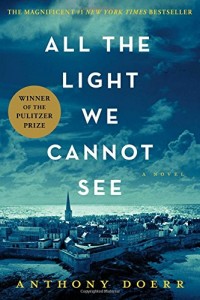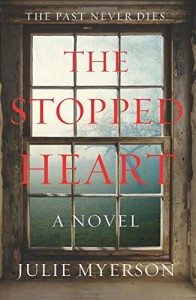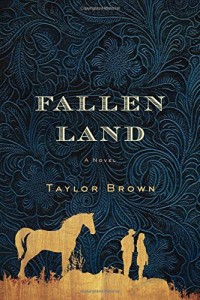My Mrs. Brown by William Norwich
I’ve been reading these ~
One is a Pulitzer-winning tale of WWII and the other a intriguing suspense novel from a UK author. While I’m enjoying both books, (simultaneously –depending on my mood) this Advanced Readers Copy on my Kindle caught my eye the other night.
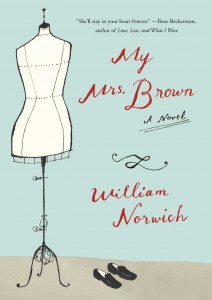 Like the most popular girl at the ball, I quickly dropped the other two books and started to dance with this one. (You may go ahead and accuse me of being a fickle reader. Okay, I’ll cop to it — it’s one of my many bibliophile flaws.)
Like the most popular girl at the ball, I quickly dropped the other two books and started to dance with this one. (You may go ahead and accuse me of being a fickle reader. Okay, I’ll cop to it — it’s one of my many bibliophile flaws.)
My Mrs. Brown has been called a feel-good book for women of a certain age and I thought – well I’ll just dip in and see if it’s worth reading. Before I knew it, I was halfway through and only stopped reading when my eyes wouldn’t stay open any longer. I finished it the next evening in one bout.
The novel is a re-telling of the 1958 novel Mrs. ‘Arris Goes To Paris by Paul Gallico and tells the story of a “woman of a certain age” in a small town in Rhode Island. Widow, Emilia Brown dresses sensibly, sewing her own clothes in browns and greys. She lives in a simple duplex and works as the cleaning lady for the local beauty salon. She looks forward to chatting each evening with her renter in the adjoining duplex – a daughter of a friend, who in her black goth outfits – startles the genteel Mrs. Brown on many subject areas, but eagerly seeks the older woman’s wise counsel…
Everything is going to be okay in the end. And if it is not okay, it isn’t the end.
Mrs. Brown is a frugal, simple woman who admires the beautiful women around her but doesn’t actually care about beauty for herself. Until the day she is helping inventory the estate of a recently deceased wealthy dowager and Mrs. Brown comes upon the dress, hanging in an almost empty closet:
Black and elegant, it is cap-sleeved with a single-button jacket made of the finest quality wool crepe. …a simple yet exquisitely tailored Oscar de la Renta sheath and jacket, that she realizes, with startling clarity, will say everything she has ever wished to convey about herself.
Mrs. Brown is quite taken with its simple elegance, yet she can’t bring herself to touch it with her work-roughed hands. The dress is simple, yet exquisitely tailored, lined with pure silk and costs more money than Mrs. Brown could ever afford. The dress is sent on to the auction house with the rest of the grand dame’s valuables, but it awakens an “invincible spring” inside Mrs. Brown.
Sometimes a dress isn’t just a dress.
She takes on extra cleaning jobs, skimps on her meals and starts saving for the dress – $7,000 –an extravagance that begins to define Mrs. Brown in ways she couldn’t imagine.
The story of how Mrs. Brown gets the money and then journeys to New York City made me smile, and then grin — the scene where she exits Penn Station and sees the New York City for the first time will resonate with anyone who remembers their first experience of that astounding and magnificent city.
Once the story moves to New York City, I must confess, it becomes a bit contrived — but in a good way, like reading Dickens — a fairy tale for grown up women. Mrs. Brown encounters kindness and help on Seventh Avenue the fashion center of Ne York — at first because she is carrying her mother’s valuable hand-me-down vintage handbag and later, because everyone, including Oscar de la Renta himself, wants to help this quiet, drab lady achieve her dream. He tells her quietly
“We’ve an expression on Seventh Avenue. It’s music to most women’s ears. ‘I can get it for you wholesale,’ and, Mrs. Brown”, Oscar said, “if I can’t get it for you wholesale, then we’re in a lot of trouble around here.”
From then on, Mrs. Brown’s story concludes towards the happy ending we hope for. The dress is procured and professionally altered to fit her perfectly, a new friend in New York City finds love — even Mrs. Brown’s life is back in her small town is changed- no her life is now charmed — because she got the dress – her dress.
Mr. Norwich (a fashion writer) has portrayed Mrs. Brown not only as a woman who is not yet past her prime, but as a true lady — maintaining her strength, grace and dignity in a world where the Mrs. Browns are often disregarded.
Most women have wished for such a dress, one which spoke to them, one which when possessed and worn could have a Cinderella affect.*
An unapologetically sweet story, not striving to be great literature, but rather to restore the reader’s faith in kindness, goodness and grace. Definitely, a feel-good novel. Now I’ll go back to my other book dates – hmmm, what am I in the mood for? WWII resistance tale or a creepy country house in the English countryside?
*Mine was a black & white, beautifully draped polyester disco dress — don’t judge — it was the late 70’s, and it was fabulous.
A digital review copy was provided by Simon & Schuster via NetGalley.
The Imperfectionists by Tom Rachman
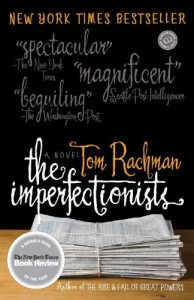 The Imperfectionists by Tom Rachman
The Imperfectionists by Tom Rachman
I always wanted to be Christiane Amanpour, international correspondent, foreign reporter. A career to dream of with exotic locations and multilingual people breaking international news –the disasters, war and brutality notwithstanding. Don’t get me wrong, I had my own great career, filled with wildly creative people, its own exotic locales and many rewards. But I sometimes still wonder…
Which is why I was drawn to this novel about a struggling English language newspaper and its employees based in Rome. Just take a look at the cover and the spectacular acclaim.
So why did it take me over two months to finish?
Sometimes funny, often heartbreaking, the individual stories, each of which focuses in on an individual employee and their unique job at the paper, are interspersed with short passages letting us into the paper’s history and the publishers’ struggles to keep it running. The paper is hardly at the cutting edge of technology–it doesn’t even have a website.
There is Lloyd, the beaten-down Paris correspondent who is willing to trick his own son for a byline. Then copy editor Ruby who has a fondness for her routines that only somewhat mask her constant fear of being fired. There’s Abby — aka Accounts Payable — the financial officer who finds herself on a plane seated next to an employee she laid off . In one of most humorous stories, you’ll meet Winston, the naive Cairo stringer who is manipulated by a wily, egotistical competitor. You’ll also read about the corrections editor, who has painstaking compiled a 18,000-word plus style guide he calls “The Bible”; woe to the unwitting writer who violates it! You’ll meet Kathleen, the arrogant, workaholic editor-in-chief who learns things about herself from a past lover that she would rather not know. There’s even a loyal reader, who has read each line of every issue since the beginning and as a result is far behind, stuck in the past and won’t let today’s paper (or any current news) into her life.
Sounds like fun, such a great collection of people, but we know from the title The Imperfectionists, that these are going to be imperfect people. Mr. Rachman goes even further to give these imperfect characters fears, greed, regrets, secrets, resentments, jealousies, and nearly unbearable sorrows. These are beautiful character sketches, filled with adultery, job loss, co-dependency, manipulation and loss of prestige and pay. The author does give us consistently beautiful writing and has an ear for gripping conversation.
But it was the theme of The Imperfectionists that grew weary — the world is a mess and nothing can or will make things better. Does no one care about their job? Does anyone care about the paper? Doesn’t anyone take delight in the fact they are living and working in Rome? (Though it is based in Rome, we see nothing of the beautiful city, culture or people – as there was no sense of place. We could be reading about Kansas City.)
I would just start to get interested in a beautifully drawn character and then slam– something horrible happens and you’re on to the next poor soul. At first this was intriguing – never knowing what the talented Mr. Rachman will do next. But towards the latter half of the novel, I started to dread the next meanness – the next cruelty. With a novel based on international reporting, one expects a share of atrocities and horrors, but this is all about misguided people and their frailties – not about politics or world issues.
I can recommend this book for its excellent writing, pitch perfect dialogue and some brilliant characterizations. And, in my on-going effort to get away from my “Pollyanna-ish” reading comfort zone, I’m glad* to have read, and most importantly, finished this novel.
But I must admit that I’m a bit schizophrenic regarding The Imperfectionists. Early on, I was gobbling down the pages, chuckling at each character, but toward the end, I could barely stand it. So little redemption, so little hope – it became a forced march.
*Pollyanna — “glad” – get it? Sometimes, I just crack myself up.
A Woman of Independent Means by Elizabeth Forsythe Hailey
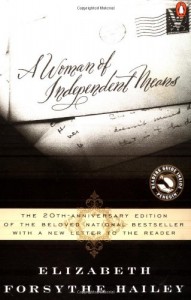 I first read this book back in 1980, just a couple of years after it was published. Embroiled in graduate school demands and anxieties, I needed a reading escape, but nothing frothy or light. My brain was working overtime, on all cylinders, and my recreational reading needed to do the same.
I first read this book back in 1980, just a couple of years after it was published. Embroiled in graduate school demands and anxieties, I needed a reading escape, but nothing frothy or light. My brain was working overtime, on all cylinders, and my recreational reading needed to do the same.
As it often is with books, I found A Woman of Independent Means as a beat-up paperback left behind on the student lounge bookshelf. It turned out to be the exact right book at the exact right time. Reading the life story of Bess, a woman who never, ever suffered from feelings of inadequacy or low self esteem, was the perfect foil to my own quivering mass of insecurities trying to survive in a often harsh and competitive environment.
In the years since, I have re-read this classic several more times and once again this past month when a new edition (above) entered my library to happily replace my original beat-up paperback, with a truly ugly cover.
This epistolary novel is comprised of one woman’s correspondence to her family, friends, and others spanning from the turn of the last Century to 1968. Bess is based on the author’s own grandmothers letters and we see Bess live through two world wars, the great depression, the influenza epidemic and the assassination of President Kennedy. She observs horse and buggy days through automobiles and from crossing the ocean by ship to air travel. We see history unfold through her letters.
The author has created a remarkable and complex woman – both ahead of her time and an ambitious, independent thinker. Bess is outspoken, brash, rebels against convention, and yet, is completely vulnerable. Through her letters, the reader watches the narcissistic Bess try to manipulate and control her loved ones’ lives — truly unaware she is overstepping and usually hurt and bewildered when they rebel.
Bess suffers financial ruin after the death of her first husband, so becomes financially savvy and sets herself up to be independently wealthy through her second marriage. As a “women of independent means” she is able to get what she wants – whenever she wants — often with grimace-worthy results:
I am very sorry to hear of my cousin’s illness. I have not received a letter from her since last summer and I was beginning to wonder what reason I had given her for such a long silence. When she regains consciousness, please tell her I wrote to express my concern.
If she does not regain consciousness, may I remind you that I am the legal owner of the four-poster bed she now occupies and in the event of her death, it is to be shipped C.O.D. to me here in Texas. Cordially, Bess Alcott Steed.
Bess’s Machiavellian actions are in stark contrast to her overwhelming need be loved and admired. She is constantly confounded by others’ actions and strives to put things right – as she sees it.
Throughout a series of of personal tragedies, Bess remains relentlessly optimistic. From the loss of her son, to the burning down of her beloved home, Bess never feels sorry for herself and is somehow stronger after each (often unbelievable) set-back.
Bess and her married daughter have a predictably difficult relationship which Bess tries to solve by inviting herself to her daughter’s social events and ingratiating herself with her daughter’s best friends. A heart wrenching letter to her daughter in 1943 is some of the best insight on aging mother/grown daughter relationships I’ve ever read.
There are many moments when Bess has the clear-sightedness of age and experience. I stopped to underline several passages such as this one:
Remember the night you and I talked until dawn with Betsy trying her eight-year-old best to stay awake with us? The others had long since fallen asleep when she suddenly saw the sun rising and burst into tears, terrified to realize morning would come whether she had slept that night or not. But better for her to learn early that nature does not ask our consent to continue its inexorable circuit.
Ms. Hailey has brilliantly crafted a complex character who will stick with you long after you close this novel’s pages. Bess is far from perfect -and I was often exasperated (and sometimes horrified) by her — yet I still shed a few tears with her. Like all fascinating characters, I was always interested in Bess, never bored by her and actually loved every moment I was allowed to spend in her presence.
Fallen Land by Taylor Brown
Mini-Review
I’m going to use Mini-Reviews for books I didn’t enjoy and can’t recommend. This doesn’t mean it isn’t a good, or even a great, book — it just means it wasn’t for me.
Fallen Land opens with an exciting historical adventure set in the final year of the Civil War, as a young couple on horseback flees a dangerous band of marauders who seek a bounty reward. Callum, Ava, and their horse, Reiver encounter the devastation and insanity of a war-torn country.
A wonderful premise, strong characters (especially the wonder horse Reiver) and an astounding sense of time and place. But the unrelenting, and sometimes gratuitous, violence — page after page — chapter after chapter — I just couldn’t stomach it any further.
Guess I’m a wimp. Takes a stronger reader than I to read and enjoy this book.
A digital review copy was provided by St. Martin’s Press via NetGalley.
The Improbability of Love by Hannah Rothschild
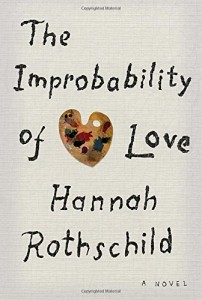 Ever since launching Book Barmy, I read with a pen and index card, making notes and jotting page numbers to reference for this blog. So I was surprised when halfway through this book I realized I hadn’t once picked up my pen. That’s a testament to this wonderful debut novel — I read for pure enjoyment, immediately lost in its pages.
Ever since launching Book Barmy, I read with a pen and index card, making notes and jotting page numbers to reference for this blog. So I was surprised when halfway through this book I realized I hadn’t once picked up my pen. That’s a testament to this wonderful debut novel — I read for pure enjoyment, immediately lost in its pages.
The Improbability of Love doesn’t fit neatly into a genre. It’s a drama, a love story, a history novel, a mystery and a satire. But mostly it is a book about art and the value of art both monetarily and emotionally.
Ms. Rothschild opens the book with a brilliant prologue which wryly captures behind the scenes at an art auction and then the cast of VIPs getting ready to bid on the art find of the century.
Then the novel goes back in time to Annie, a poor but accomplished chef who ducks into a secondhand store and buys a small, dusty painting which, unbeknownst to her, is an original Antoine Watteau, the French artist who revitalized the Baroque style of painting.
And so it begins…
Soon there is a large cast of colorful characters surrounding her little painting — unsavory art dealers, arrogant art experts, narcissistic art patrons, eccentric artists, wildly wealthy Russians in exile, and Barty a cross-dressing little man who makes his living instructing the newly rich on how to fit into society. Hitler’s art squad and a hidden identity also come into play, which adds more layers of mystery and intrigue.
In several chapters, the author tells the story from the perspective of the painting itself – this technique is fascinating in the beginning but gets bogged down later in the book as the painting tries to delineate its provenance from his starving artist through royalty, war, and finally modern day obscurity.
I especially enjoyed the author’s characterization of the rich art patrons and their decadent and spoiled worlds:
“Poor Aunty Jo”, Emeline said with feeling. “She never got over losing Topper.”
“I thought her husband was called Charles?”
“He was — Topper was her Pekinese.”
Annie secures a catering job for a Mrs. Appledore, one of the wealthy art patrons and with a “sky is the limit” budget recreates a dinner from art history. The description of the evening from decorating the dining room to the countless courses in this epic dinner is a wonder of descriptive food writing.
That said, Ms. Rothschild really shines with her knowledge of art history and her evocative descriptions of the art works, their history and the impact these paintings had on people’s lives. She opens our eyes to the dirty underbelly of fine art – thievery, cheating and outright greed brought most of today’s fine works of art to museums around the world. But the reader senses the author’s overriding sense of love – love of artists, the patrons, the business of art and especially the beauty of art.
The Improbability of Love is a totally entertaining read — an accomplishment of wicked humor, counterbalanced with war crimes — outrageous conspicuous consumption, mirrored against the reverence and importance of art in all its many forms.
Thanks to my friend Michael for loaning me his copy of this book.
Did You Ever Have a Family by Bill Clegg
At first, I rejected this book because in the opening chapters — the main character, June, looses her entire family in a horrific home accident, and with the cruelest twist of all – on the eve of her daughter’s wedding. I closed the book thinking, well this…
But then I read that Did You Ever Have a Family was nominated for both the Man Booker Prize and National Book Award and reviewers were using words such as “wondrous, eloquent and beautifully nuanced”. I decided to give it a another go. I vowed to give it four or five chapters this time.
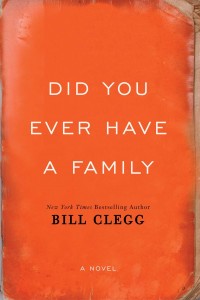 That did it, I was totally captured — caring so much about the characters that I couldn’t stop reading. Yet, I found myself reading slowly to fully absorb the language and the wisdom within its pages. But, be prepared, Did You Ever Have a Family is unusual — beyond just the missing question mark in the title — very little happens in the present and there is only a smattering of dialogue.
That did it, I was totally captured — caring so much about the characters that I couldn’t stop reading. Yet, I found myself reading slowly to fully absorb the language and the wisdom within its pages. But, be prepared, Did You Ever Have a Family is unusual — beyond just the missing question mark in the title — very little happens in the present and there is only a smattering of dialogue.
Mr. Clegg guides us through the devastation a tragedy brings to a small community and how the pain can spatter far and wide. With each chapter, he allows those effected to open their hearts.
Each character slowly reveals their memories and accounts. Everyone is linked, some in minor ways — others with strong connections. And it’s these connections that the author deftly weaves together into a bittersweet tapestry of people who love, who care and form more than just a community, but a family. This comes alive with some gorgeous writing – as here, with Lydia, a waitress in the diner :
When you see someone every day for a while, you settle into a rhythm and you come to count on them even if for nothing more than fifteen minutes each morning they spend sitting at your counter, on one of your stools, talking about the weather and giving you a big smile and thumbs up when they sink their teeth into a poppyseed muffin.
The quiet heartache of this novel will resonate with anyone who has lost a loved one. But surprisingly Mr. Clegg counteracts the sadness with the characters revealing little snippets of past and present happiness. Many of their happiest moments and memories are the little things — which often turn out to be enormous. I underlined this sentence and re-read it several times, simply lovely…
All we can do is play our parts and keep each other company. And it might be you never know the part you played.
Did You Ever Have a Family concludes 3,000 miles away from the original tragedy, with a gentle happiness warily gathering around the main characters. As if their new community – this new family — is a healing shawl around their shoulders .
I closed this book thinking how grateful I am for the communities that surround me — friends and family, of course, but also those people you may think don’t affect your life, but at the end of the day are all part of your story and your community.
Yes, Did You Ever Have a Family is sad, but it is also a heartening testament to the fundamental human need to connect with others. Those that keep us getting out of bed each morning, those we care for, worry about, love and if we’re lucky – wonders of wonders – they love us back.
A digital review copy was provided by Simon & Schuster via NetGalley.


